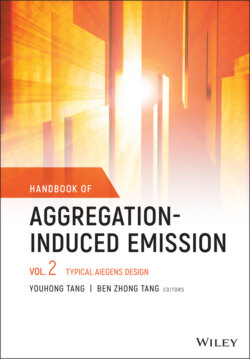Читать книгу Handbook of Aggregation-Induced Emission, Volume 2 - Группа авторов - Страница 27
2.2.1.1 Piezofluorochromic Materials
ОглавлениеPiezofluorochromic material is a kind of intelligent material whose fluorescence properties change with the external pressure stimulation. They have a wide range of applications in the fields of sensor, intelligent chip, anti‐counterfeiting ink, and so on. At present, many DSA derivatives with piezofluorochromic properties have been designed and synthesized, and their remarkable piezofluorochromic properties were systematically investigated [25, 26].
Figure 2.1 Small molecules of 9,10‐distyrylanthracene (DSA) derivatives exhibiting response luminescence upon external stimulus.
Figure 2.2 Compounds based on DSA exhibiting response luminescence upon external stimulus.
Tian et al. reported that DSA derivative 1‐1 (see Figure 2.1), named 9,10‐bis((E)‐2‐(pyrid‐2‐yl)vinyl)anthracene, changed its emission color from green to yellow when the powder was under the conditions of grinding or static pressure [22]. At high pressure, the emission color of 1‐1 powder eventually turns red. Through the research of single‐crystal structure, in situ high‐pressure fluorescence spectrum, and theoretical calculation, it was found that the shift in fluorescence emission from green to red results from the enhanced π–π interaction between adjacent anthracene planes in the crystal and increased exciton coupling and orbital overlap between neighboring molecules. The powder of DSA derivative 1‐2 (see Figure 2.1) [27] has the same fluorescence change after grinding and will change to the initial state after heating at 170 °C for about 20 minutes.
Chi et al. reported a series of DSA derivatives 1‐3, 1‐4, 1‐5, and 1‐6 (see Figure 2.1), which are substituted by triphenylethylene and tetraphenylethylene [28]. These compounds have the property of aggregation‐induced enhanced emission (AEE), and their fluorescence color changes significantly under pressure. After annealing, they can be restored to the initial state. In addition, all of the four DSA derivatives 1‐7, 1‐8, 1‐9, and 1‐10 (see Figure 2.1) substituted by carbazoles have piezofluorochromic properties, and the piezofluorochromic effect of the compound with more carbazole groups is more obvious [29, 30]. By studying the fluorescence changes of the powder under different conditions (grinding, annealing, and solvent treatment), it is proved that the piezofluorochromic properties of the powder can be greatly enhanced by the introduction of the carbazole group in the DSA AEE structure. These excellent properties allow these compounds to be used as stimulus response and luminescent materials in the fields of recording and pressure sensing.
Chi and Yang's group studied a series of DSA‐based compounds 1‐17, 1‐18, 1‐19, 1‐20, 1‐21, and 1‐22 (see Figure 2.2) with different alkyl chain lengths [31–38]. It was found that the length and structure of different substituents have significant effects on the piezofluorochromic properties of the DSA macromolecular materials. Combined with the crystal structure, it can be observed that the length of the substituent will affect the conformation of the molecules and change their aggregation structure, leading to different optical properties.
Besides the above DSA derivatives, some other AIE molecules based on DSA with piezofluorochromic properties have also been reported. The effects of different factors such as isomerization of butyl groups, alkoxy‐position, and length of alkoxy chains on the piezofluorochromism were investigated [39–43].
